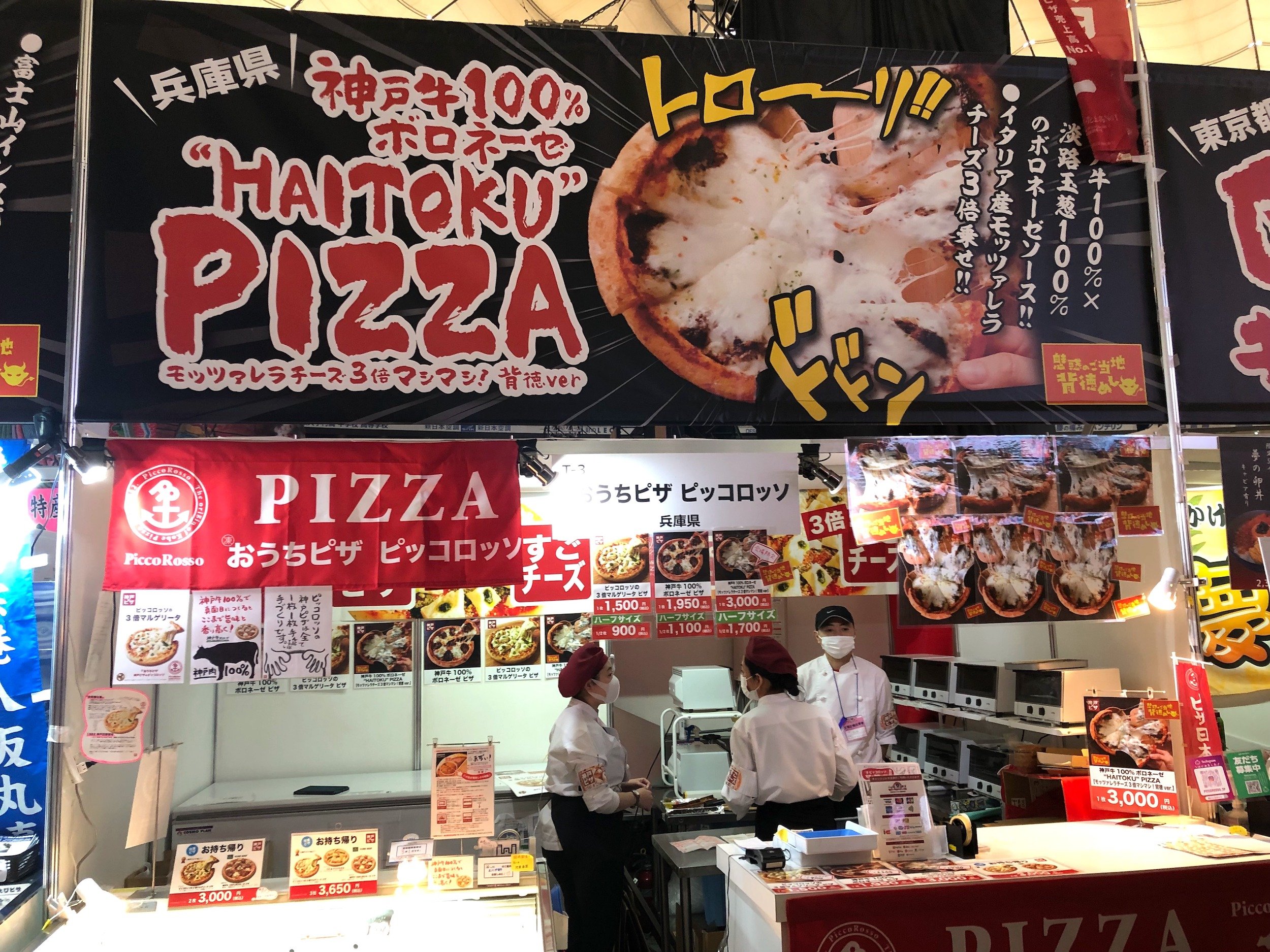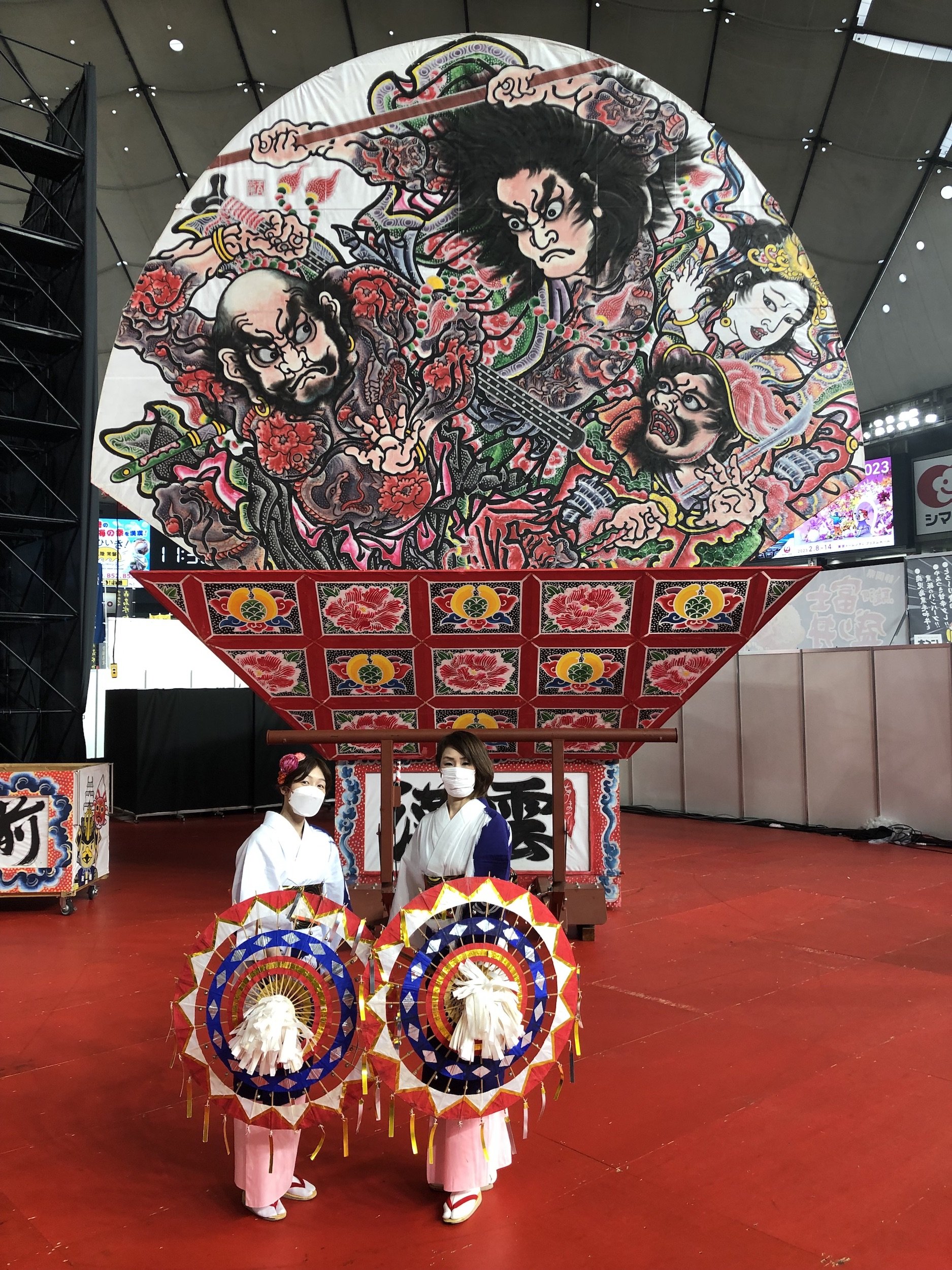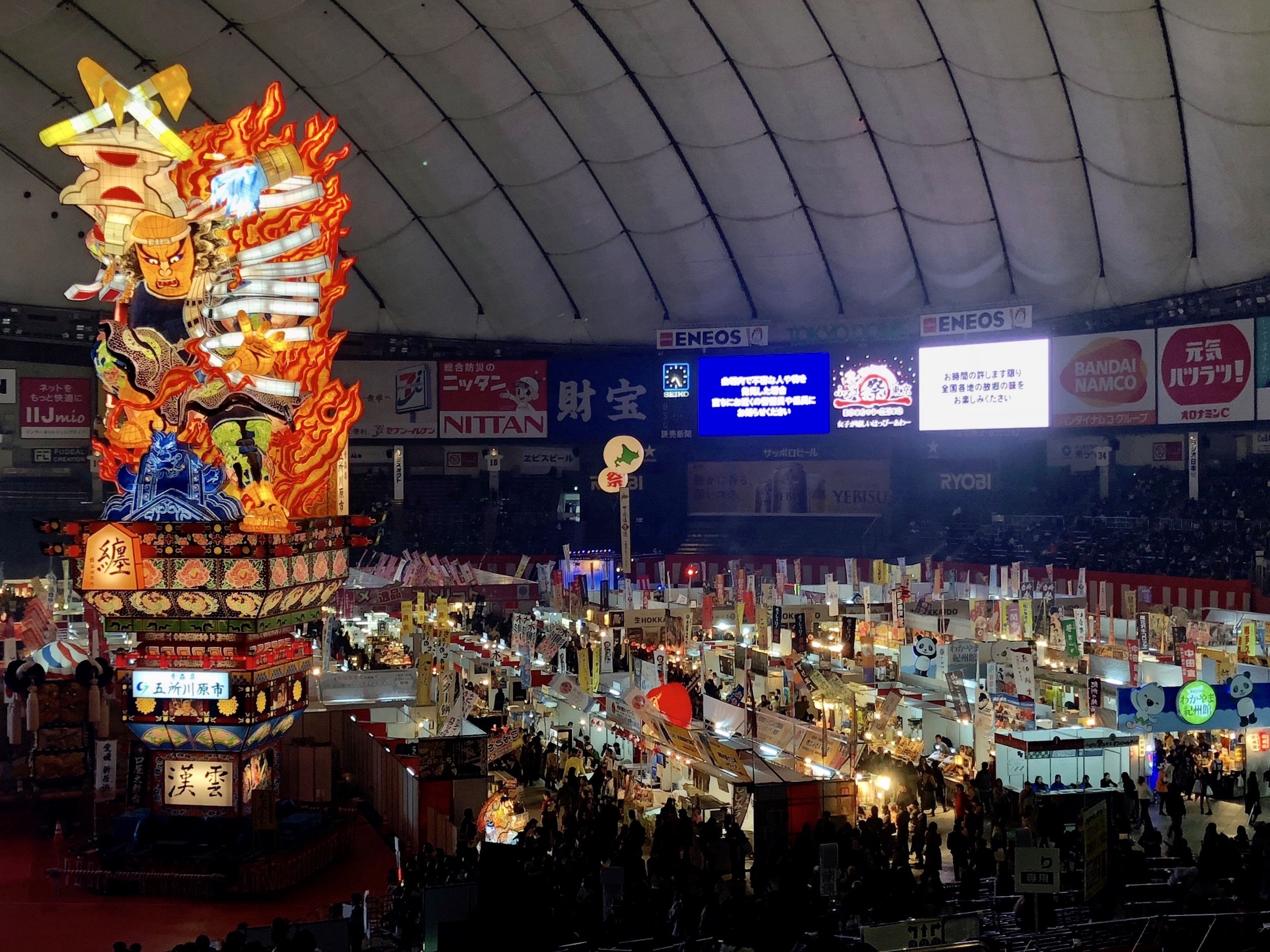Every January, Tokyo Dome—the home stadium of the Yomiuri Giants baseball team—hosts Furusato Matsuri, the “Hometown Festival.” Regional food and festival culture from all over Japan converge at this event, which is currently underway (and which I had attended twice before, once in 2017 and once in 2018). A Nebuta parade float from Aomori is one of the annual centerpieces. This year, someone we know happened to be a member of the team whose float was on display.
Eat Till You Drop
For foodies, one of the best things about Furusato Matsuri is that it lets you take a culinary tour of Japan, eating outward from the capital, as it were. They have food stalls set up all over the stadium in the place where the field would be during baseball season. We shared street food like miso milk curry ramen from Aomori, kakuniman from Nagasaki, a crab scallop shell from Sapporo, a hamburger rice bowl from Kagoshima, and haitoku (literally: “immoral,” or sinfully cheesy) Kobe beef pizza.
Many of those are cities I’ve visited at one time or another. Though we didn’t eat Osaka food (having just gotten back from there), that place was with us in spirit, too, as we ignored all pretense of New Year’s dieting resolutions and instead engaged in kuidaore, the time-honored custom of eating till you drop. I didn’t realize it at the time, but even two of the trays they served us were edible. No joke!
On the festival side of things, Furusato Matsuri 2023 also gave us a chance to reconnect with more than one place outside Tokyo that we’ve been to in recent months…
Where the Festivals Come to You
When we traveled to Aomori last summer, Azusa’s old coworker showed us around the city and even took us back inside the tent where the NTT-sponsored float for the 2022 Nebuta Festival was being worked on. We saw many lit-up floats in action on the street that night, but they rotate the teams, and the NTT team had just performed the night before. Our trip was planned around Azusa’s work schedule, so we could only be there for two days and that one night. We never got to see the NTT float illuminated outside the tent or participating in the parade.
The second leg of our summer travels took us to Tottori a week later, where we had another near-miss with the Tottori Shan Shan Festival.
“Shan Shan” is an onomatopoeia for the sound of bells ringing and hot springs bubbling. We were mainly in Tottori to see the Sand Dunes and Sand Museum, but we saw some decorations up for the Shan Shan Festival, which involves local dancers twirling colorful umbrellas. From our hotel room window, we could even see some of the dancers practicing on a nearby rooftop.
We left Tottori on August 13th, the 12-year anniversary of the day I left the U.S. to come to Japan. They had some kind of ticketed pre-event that day, but it was sold out and the main umbrella dance parade wasn’t until the next day—meaning we’d missed yet another bit of festival fun by just 24 hours.
Furusato Matsuri set things right this week by bringing the festivals right to us in Tokyo.
Yosakoi, Awa Odori, and the Tottori Shan Shan Festival
Furusato Matsuri 2023 began on Friday, January 13, and ends on Sunday, January 22. I ended up getting a double dose of it this week, first on the weekend with Azusa, then again yesterday to see the Tottori Shan Shan Festival and Aomori Nebuta Festival performances back-to-back.
As we exited Suidobashi Station and passed through the gate to Tokyo Dome City last Sunday, we saw a bunch of yosakoi dancers gathered outside the stadium. Another woman Azusa knows through her job was there; we had seen her yosakoi team perform in Chofu and on live national television on New Year’s Eve as part of Kohaku, the yearly music special.
Inside Tokyo Dome, there was another big performance that day where the floor was filled with Awa Odori dance teams from across town in Koenji. I’ve seen and done enough Awa Odori to last a lifetime, so I was content to just watch that on the jumbotron overhead as we grazed on Sapporo seafood.
Yesterday, a smaller team of umbrella dancers from Tottori performed at 11:10 a.m. The video clip below shows part of their opening number, which played out to old-fashioned, Bon Odori-style festival music.
They also did a more up-tempo, modern dance number to the tune of “Shan Shan Shangri-La.” Afterward, they opened up the floor for a short time so people could come down from the stands and get up close and personal with the dancers and their umbrellas. Two of them even posed for me in front of a Hirosaki Neputa float, thereby representing culture from one side of Honshu to the other.
AOmori Nebuta and Neputa Floats (and Catfish Yokai)
The last time we attended Furusato Matsuri in 2018, there was a towering Tachineputa float from Goshogawara, another city in Aomori Prefecture, on prominent display in Tokyo Dome (see above). This year was more like 2017, where it was just the Nebuta and Neputa floats from the neighboring cities of Aomori and Hirosaki (see below).
On Sunday, we saw both floats up close when they opened the floor for a greeting with local mascots from across Japan. It seems like there’s only a short window of time where you can see the Aomori one lit up each day, but yesterday at noon sharp, I caught the full performance, where the Nebuta team brought it right up to the edge of the stands, as you can see in the video below.
After mingling with the Shan Shan dancers from Tottori, I had just enough time to go to the bathroom and get back to my seat before the lights went down, the thundering taiko drums started up, and the energetic haneto dancers from Aomori hopped out, chanting, “Rasserah!”
After that, I managed to get up close with the front and back of the lit lantern float down on the floor for a few minutes before they started herding people out again for the next performance.
Tonight, we met up with Azusa’s old co-worker, the NTT manager who showed us around Aomori, at an izakaya. I was curious to pick his brain about the design of the Nebuta float and the various dragons, nazuma (catfish), and fiery-headed yokai figures it depicts.
He said the float was designed by Shunichi Kitamura, whose father and sister are also Nebuta designers. We’ve seen the sister, Asako Kitamura, on TV, too. Apparently, back in the old days, frisky catfish were seen as an earthquake omen, so that’s maybe how they came to be associated with a giant one underground named Namazu causing quakes. It’s since been scientifically proven that catfish can detect quakes.
Accessing Tokyo Dome
To see Furusato Matsuri at Tokyo Dome, you’ll head to the nexus of several train stations in Bunkyo Ward, including Kasuga Station on the Oedo Subway Line and Korakuen Station on the Marunouchi Subway Line (both of which I’ve used in the past when I was teaching part-time business English courses in the city circa 2014–2015). The straightest shot to reach it from Shinjuku, however, seems to be Suidobashi Station via the JR Chuo-Sobu Line. This is the same line you’d use in the summer if you were going to see Koenji’s real Awa Odori Festival.



















